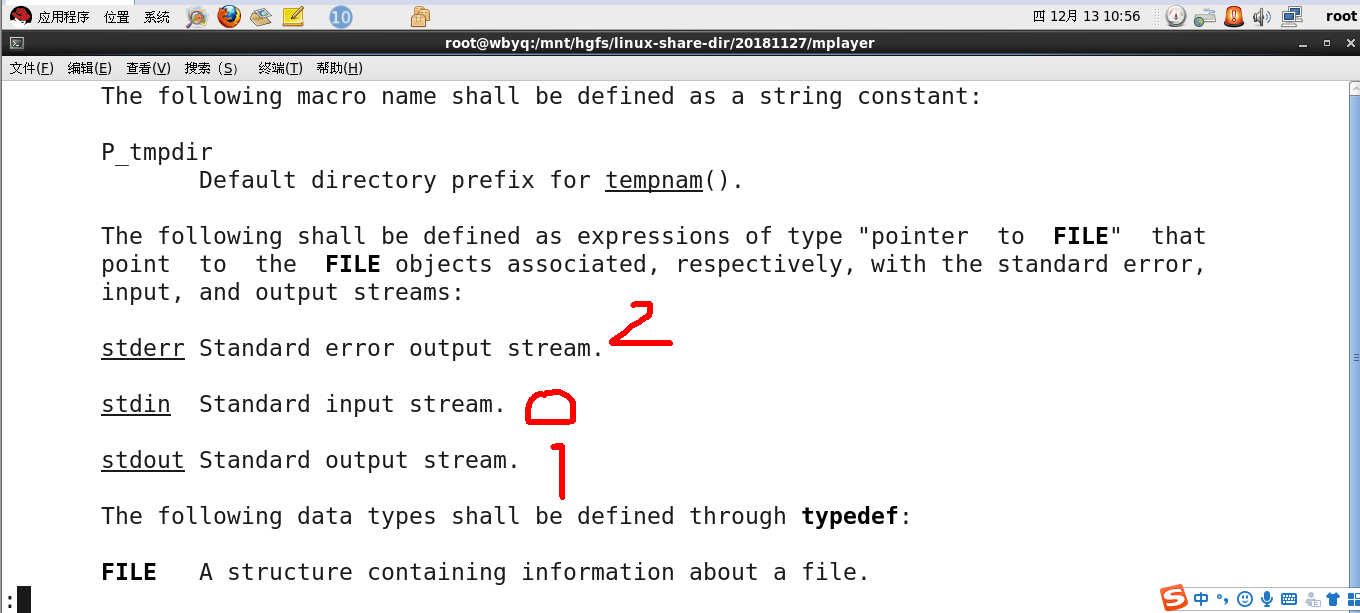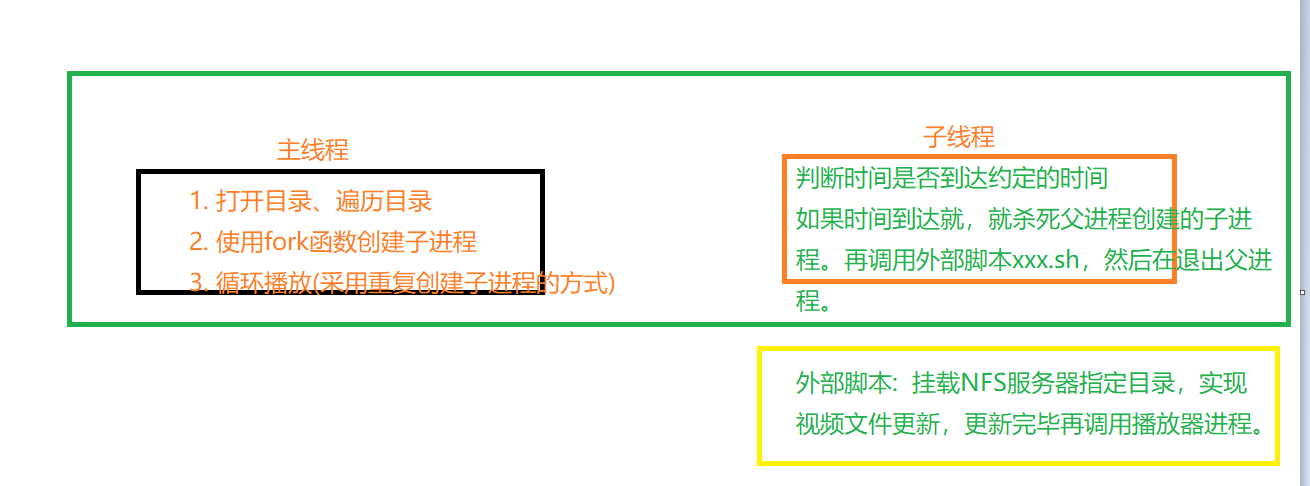Linux 驱动开发 _ 视频广告机开发、Linux 进程编程介绍
- 2022 年 6 月 07 日
本文字数:7355 字
阅读完需:约 24 分钟
介绍 Linux 下进程编程知识点,学习 fork 函数、管道、消息队列、共享内存、信号等同通信方式。并且介绍了广告机小项目的实现方法。
任务 1: 学习 Linux 下进程编程
1. 进程简介
进程是操作系统调度的最小单元,线程是进程内部的执行单元,一个进程默认有一个主线程。
进程在操作系统里使用 PID 号作为标识符号----查看当前终端运行的进程: ps 。

每个进程之间的资源都是独立的。--------进程可以自己独立的运行、带 main----------
主要的知识点:
【1】进程间通信: 管道(无名管道、命名管道)、消息队列、共享内存、内存映射(mmap)、信号。
【2】execl 函数族: 用于启动一个新的进程,新的进程开始执行之后,会覆盖原来进程空间。
【3】dup2 函数: 复制文件表。------实现文件描述符重定向。 dup2(fds[1],1);
【4】编写广告机播放器程序
【5】编写 shell 脚本,实现文件同步
1.1 进程创建
#include <unistd.h> pid_t fork(void);
功能: 在当前进程里再创建一个子进程。
函数返回值: ==0 表示子进程,>0 表示父进程,<0 表示出现错误
新创建的子进程特性: 在 fork 成功那一刻,会将父进程所有的资源全部拷贝一份,重新运行。
僵尸进程: 子进程先退出,父进程没有清理子进程的空间。如何清理子进程空间? wait();
孤儿进程: 父进程比子进程先退出。避免,就是父进程要保证最后退出。
1.2 等待子进程退出,并且清理子进程空间
#include <sys/types.h>
#include <sys/wait.h>
pid_t wait(int *status);
函数功能: 随机等待一个子进程退出,并清理子进程资源。
返回值: 返回退出的子进程PID号。
函数的形参: int *status可以保存进程退出的状态。 exit(-1); //结束当前进程。
pid_t waitpid(pid_t pid, int *status, int options);
函数: 可以指定特定的PID号。-1表示所有子进程。
#include <stdio.h>
#include <sys/types.h>
#include <sys/stat.h>
#include <fcntl.h>
#include <sys/ioctl.h>
#include <unistd.h>
#include <stdlib.h>
int main(int argc,char **argv)
{
int pid;
/*创建子进程*/
pid=fork();
if(pid==0) //子进程
{
printf("子进程正常运行!....\n");
sleep(1);
/*结束当前进程*/
exit(0);
}
else if(pid>0) //父进程
{
int state=0; //保存子进程退出状态值
/*阻塞-等待子进程退出*/
wait(&state);
printf("父进程提示: 子进程已经安全退出! 子进程退出的状态=%d\n",state);
}
else
{
printf("进程创建错误!");
}
return 0;
}
1.3 终止当前进程
#include <unistd.h>
void _exit(int status);
#include <stdlib.h>
void _Exit(int status);
#include <stdlib.h>
void exit(int status);
1.4 管道通信
管道: FIFO 文件,特性: 先入先出。
1.4.1 无名管道: 有亲缘关系之间的进程才可以使用无名管道进程通信。
无名管道这个 FIFO 文件没有实体。
如果创建无名管道?
#include <unistd.h>
int pipe(int pipefd[2]);
函数形参: 传入一个数组的首地址。
管道创建成功之后: [0]表示(FIFO)无名管道读端。 [1]表示(FIFO)无名管道写端。

#include <stdio.h>
#include <sys/types.h>
#include <sys/stat.h>
#include <fcntl.h>
#include <sys/ioctl.h>
#include <unistd.h>
#include <stdlib.h>
#include <string.h>
int main(int argc,char **argv)
{
int pid;
int pipefd[2];
/*创建无名管道*/
pipe(pipefd);
/*创建子进程*/
pid=fork();
if(pid==0) //子进程
{
printf("子进程正常运行!....\n");
sleep(1);
char *p="1234567";
write(pipefd[1],p,strlen(p)+1); //向管道的写端写入数据
/*结束当前进程*/
exit(0);
}
else if(pid>0) //父进程
{
int state=0; //保存子进程退出状态值
char buff[100];
read(pipefd[0],buff,100); //从管道的读端读取数据
printf("父进程收到的数据=%s\n",buff);
/*阻塞-等待子进程退出*/
wait(&state);
printf("父进程提示: 子进程已经安全退出! 子进程退出的状态=%d\n",state);
}
else
{
printf("进程创建错误!");
}
return 0;
}
1.4.2 命名管道通信
命名管道可以在任何进程间通,因为命名管道是一个实体文件,在磁盘可用找到该 FIFO 文件。
如何在磁盘上创建管道文件:
#include <sys/types.h>
#include <sys/stat.h>
int mkfifo(const char *pathname, mode_t mode);
管道文件不能在共享目录下创建。(挂载的目录)
1.5 dup2 函数学习
#include <unistd.h>
int dup2(int oldfd, int newfd);
示例: dup2(fds[1],1); //接下来对文件描述符1的操作都是相当于对管道fds[1]操作。
文件描述符在内核里对应的是一个文件结构体。
示例 1:
#include <stdio.h>
#include <sys/types.h>
#include <sys/stat.h>
#include <fcntl.h>
#include <sys/ioctl.h>
#include <unistd.h>
#include <stdlib.h>
#include <string.h>
int main(int argc,char **argv)
{
int pid;
int pipefd[2];
/*创建无名管道*/
pipe(pipefd);
/*创建子进程*/
pid=fork();
if(pid==0) //子进程
{
printf("子进程正常运行!....\n");
dup2(pipefd[1],1);
//pipefd[1]管道写端,1表示当前进程的标准输出
sleep(1);
printf("---1234567---\n");
/*结束当前进程*/
exit(0);
}
else if(pid>0) //父进程
{
int state=0; //保存子进程退出状态值
char buff[100];
read(pipefd[0],buff,100); //从管道的读端读取数据
printf("父进程收到的数据=%s\n",buff);
/*阻塞-等待子进程退出*/
wait(&state);
printf("父进程提示: 子进程已经安全退出! 子进程退出的状态=%d\n",state);
}
else
{
printf("进程创建错误!");
}
return 0;
}
示例 2: 日志功能制作。
#include <stdio.h>
#include <sys/types.h>
#include <sys/stat.h>
#include <fcntl.h>
#include <sys/ioctl.h>
#include <unistd.h>
#include <stdlib.h>
#include <string.h>
int main(int argc,char **argv)
{
/*1.创建存放日志的文件*/
int fd=open("/log.txt",O_RDWR|O_CREAT,S_IRUSR|S_IWUSR);
/*2. 重定向(将标准输出重定向到fd)*/
dup2(fd,1);
/*3. 向日志文件写入数据*/
printf("12345\n");
printf("abcd\n");
printf("日志文件测试!\n");
/*4. 关闭日志文件*/
close(fd);
return 0;
}
1.6 execl 函数族
#include <unistd.h>
extern char **environ;
int execl(const char *path, const char *arg, ...);
int execlp(const char *file, const char *arg, ...);
int execle(const char *path, const char *arg,..., char * const envp[]);
int execv(const char *path, char *const argv[]);
int execvp(const char *file, char *const argv[]);
execl 功能介绍: 启动新的子进程,当子进程启动成功之后会覆盖原来的进程空间。
Execl 函数族介绍:
【1】带 p 表示可执行文件可以从环境变量里获取。
【2】不带 p 表示,可执行文件需要填绝对路径。
【3】带 e 表示最后的参数,可以给新进程设置新的环境变量。
说明: 参数列表最后面都要加一个 NULL。
#include <stdio.h>
#include <sys/types.h>
#include <sys/stat.h>
#include <fcntl.h>
#include <sys/ioctl.h>
#include <unistd.h>
#include <stdlib.h>
#include <string.h>
int main(int argc,char **argv)
{
/*以ls命令为例子,讲解*/
//execl(<可执行程序的路径>,<执行的形参列表>,NULL);
//execl("/bin/ls","ls","-l",NULL);
//execlp("ls","ls","-l",NULL);
//char *envp[]={"PATH1=12345",NULL};
//execle("/bin/ls","ls","-l",NULL,envp);
//获取环境变量的值: getenv("PATH1");
//char *argvs[]={"ls","-l",NULL};
//execv("/bin/ls",argvs);
char *argvs[]={"ls","-l",NULL};
execvp("ls",argvs);
printf("执行失败!\n");
return 0;
}
//ls -l
1.7 mplayer 播放器
Mplayer 运行有两个模式: 1. 主模式 2.从模式

#include <stdio.h>
#include <sys/types.h>
#include <sys/stat.h>
#include <fcntl.h>
#include <sys/ioctl.h>
#include <unistd.h>
#include <stdlib.h>
#include <string.h>
#include <pthread.h>
/*
获取标准输入的数据、写给FIFO文件
*/
void *pthread_func(void *argv)
{
int fd=open("/mplayer_fifo",2);
if(fd<0)
{
printf("FIFO文件打开失败!\n");
pthread_exit(NULL); //结束当前线程
}
char buff[100];
int len;
while(1)
{
printf("请输入命令:");
fflush(stdin); //刷新缓冲区
fgets(buff,100,stdin); //从键盘上获取数据 get_percent_pos get_file_name
len=strlen(buff); // get_file_name [0~12] [13]='\n'
write(fd,buff,len); // get_file_name '\n'
memset(buff,0,100);
}
}
int main(int argc,char **argv)
{
int pid;
/*1. 创建无名管道*/
int fds[2];
pipe(fds);
/*2. 创建子进程*/
pid=fork();
/*子进程代码: mplayer播放器*/
if(pid==0)
{
/*将子进程的标准输出重定向到管道写端*/
dup2(fds[1],1);
/*启动子进程*/
execlp("mplayer","mplayer","-zoom","-x","800","-y","480","-slave","-quiet","-input","file=/mplayer_fifo","/work/video_file/Video_2018-12-11.wmv",NULL);
}
else /*父进程*/
{
char buff[100];
int cnt=0;
/*创建新的线程: 从键盘上获取输入的数据,写给播放器的FIFO文件*/
pthread_t threadID;
pthread_create(&threadID,NULL,pthread_func,NULL);
pthread_detach(threadID); //设置分离属性
while(1)
{
/*从管道的读端读取数据: 读取就是mplayer播放器输出的数据*/
cnt=read(fds[0],buff,100);
buff[cnt]='\0';
printf("播放器输出的值=%s\n",buff);
}
}
return 0;
}
任务 2: 广告机项目
广告机项目要求:
广告机应用场景: 公交站台、地铁车厢、银行前台大厅、高速公路、公园….
【1】有些广告机只有视频播放,没有声音。
【2】广告机都支持网络视频文件更新---->文件更新使用现成的服务器: FTP 服务器、NFS 服务器。
(1) 如何判断服务器上那些文件需要下载到本地? 通过 shell 脚本代码或者使用 C 语言。
(2) 更新的时间一般是固定的: 20:00 23:00 …… 通过时间函数判断时间是否到达。
(3) 在视频文件更新的时候,视频需要停止播放,可以在屏幕上显示提示(正在更新…..)。
【3】广告机需要支持自动播放,播放一个自动切换下一个、循环播放。
调用读目录、循环遍历目录、得到视频文件、mplayer 播放器需要使用子进程方式启动。
广告机: 音量调整、选择视频播放…….都不是广告机的功能---是视频播放器的功能。

示例代码:
#include <stdio.h>#include <sys/types.h>#include <sys/stat.h>#include <fcntl.h>#include <sys/ioctl.h>#include <unistd.h>#include <stdlib.h>#include <string.h>#include <pthread.h>#include <sys/types.h>#include <dirent.h>#include <signal.h>#include <time.h>
/*-----------全局变量区------------*/int log_fd; /*保存日志文件的文件描述符*/#define LOG_FILE "/log.txt" /*日志文件存放的路径*/DIR *video_dir_p=NULL; /*存放视频的目录: 打开的目录指针*/int video_state=0;
#define VIDEO_FILE_PATH "/work/video_file/" //存放视频文件的目录#define UPDATE_HOUR 16 //更新的时间: 小时#define UPDATE_MIN 38 //更新的时间: 分钟#define UPDATE_SEC 00 //更新的时间: 秒
/*-------函数声明---------*/void DeleteListALLNode(void);
/*定义链表使用的结构体*/struct VideoList{ char *file_path; struct VideoList *next;};
/*链表头*/struct VideoList *ListHead=NULL;
/*函数: 信号处理函数*/void exit_sighandler(int sig){ /*1. 判断是什么信号*/ if(sig==2) { printf("用户终止了进程!\n"); } else if(sig==11) { printf("进程访问了非法内存空间!\n"); } /*2. 杀死父进程对应所有子进程*/ char cmd_buff[100]; //杀死父进程创建所有子进程,父进程本身不受影响 sprintf(cmd_buff,"pkill -9 -P %d",getpid()); system(cmd_buff); sleep(2); /*3. 关闭打开所有的文件或者目录*/ close(log_fd); closedir(video_dir_p); DeleteListALLNode(); /*4. 退出父进程*/ exit(1);}
/*函数功能: 获取本地时间,判断是否是否到达预设的时间*/void *Time_pthread_func(void *argv){ time_t time1; time_t time2; struct tm *system_time; char cmd_buff[100]; while(1) { time1=time(NULL); //获取当前系统的时间秒单位 if(time1!=time2) //保证if每1秒进去一次 { time2=time1; system_time=localtime(&time1); //将秒单位时间,转成标准时间结构 printf("%d-%d-%d\n",system_time->tm_hour,system_time->tm_min,system_time->tm_sec); /*更新的时间*/ if(system_time->tm_hour==UPDATE_HOUR && system_time->tm_min==UPDATE_MIN && system_time->tm_sec==UPDATE_SEC) { video_state=1; //表示进程需要终止 //"pkill -9 -P <父进程的PID>" //杀死父进程创建所有子进程,父进程本身不受影响 sprintf(cmd_buff,"pkill -9 -P %d",getpid()); /*执行命令*/ system(cmd_buff); printf("正在结束子进程!\n"); pthread_exit(NULL); } } }}
/*函数功能: 扫描目录下的所有文件,加载到链表里*/void ScanDirFile(){ struct dirent *dir_file; struct VideoList *head_p=ListHead; //保存链表头的地址 struct VideoList *new_p=NULL; while(dir_file=readdir(video_dir_p)) { //过滤掉.和.. if(strcmp(dir_file->d_name,".")==0 || strcmp(dir_file->d_name,"..")==0) { continue; } //创建新节点 new_p=(struct VideoList*)malloc(sizeof(struct VideoList)); if(new_p==NULL) { printf("创建新节点空间申请错误!\n"); return; } //申请存放文件名称的空间 new_p->file_path=malloc(strlen(VIDEO_FILE_PATH)+strlen(dir_file->d_name)+1); if(new_p->file_path==NULL) { printf("申请存放文件名称的空间错误!\n"); return; } //拼接路径 strcpy(new_p->file_path,VIDEO_FILE_PATH); strcat(new_p->file_path,dir_file->d_name); printf("播放的列表:%s\n",new_p->file_path); //添加新的节点 while(head_p->next!=NULL) { head_p=head_p->next; } head_p->next=new_p; new_p->next=NULL; }}
/*函数功能: 删除链表节点*/void DeleteListALLNode(void){ struct VideoList *head_p=ListHead; //保存链表头的地址 struct VideoList *tmp_p; struct VideoList *delete_p; if(head_p!=NULL && head_p->next==NULL) { free(head_p); //释放链表头 } else if(head_p->next!=NULL) { tmp_p=head_p->next; free(head_p); //释放链表头 while(tmp_p->next!=NULL) { delete_p=tmp_p; tmp_p=tmp_p->next; free(delete_p->file_path); free(delete_p); } free(tmp_p->file_path); free(tmp_p); }}
int main(int argc,char **argv){ int pid; int state=0; struct VideoList *next_p=ListHead; /*1. 注册将要捕获的信号*/ signal(SIGINT,exit_sighandler); /*进程终止信号:Ctrl+C*/ signal(SIGSEGV,exit_sighandler); /*进程访问了非法内存*/ /*2. 创建日志文件: 保存mplayer播放器的输出*/ log_fd=open(LOG_FILE,O_RDWR|O_CREAT,S_IRUSR|S_IWUSR); /*3. 打开目录*/ video_dir_p=opendir(VIDEO_FILE_PATH); if(video_dir_p==NULL) { printf("%s 存放视频的目录打开失败!\n",VIDEO_FILE_PATH); exit(1); } /*4. 创建新的线程:判断更新时间*/ pthread_t threadID; pthread_create(&threadID,NULL,Time_pthread_func,NULL); pthread_detach(threadID); //设置分离属性 /*5. 遍历目录,更新链表*/ //创建链表头 ListHead=(struct VideoList*)malloc(sizeof(struct VideoList)); if(ListHead==NULL) { printf("链表头创建失败!\n"); exit(1); } ListHead->next=NULL; //下个节点为NULL //扫描目录,并将目录下的文件添加到链表 ScanDirFile(); next_p=ListHead; //链表头 next_p=next_p->next; //取出数据节点 LOOP: //该标签表示继续播放下一个视频时,重复创建子进程
printf("正在播放视频名称:%s\n",next_p->file_path); /*创建子进程*/ pid=fork();
/*子进程代码: mplayer播放器*/ if(pid==0) { /*将子进程的标准输出重定向到日志文件*/ dup2(log_fd,1); /*启动子进程*/ execlp("mplayer","mplayer","-zoom","-x","800","-y","480","-slave","-quiet","-input","file=/mplayer_fifo",next_p->file_path,NULL); } /*父进程代码: 控制播放*/ else { /*等待子进程退出*/ wait(&state); //判断是否需要结束当前进程 if(video_state==1) { /*执行外部脚本: 启动视频文件更新*/ system("./update_video.sh"); /*退出父进程*/ DeleteListALLNode(); close(log_fd); closedir(video_dir_p); exit(0); } /*遍历链表的下一个节点,取出文件名称,传递给子进程*/ if(next_p->next==NULL) //表示视频播放完毕 { printf("视频播放完毕---->链表归位!\n"); next_p=ListHead; //链表头 next_p=next_p->next; //取出数据节点 } next_p=next_p->next; //取出数据节点 /*再次启动子进程,播放下一个视频*/ goto LOOP; } return 0;}
版权声明: 本文为 InfoQ 作者【DS小龙哥】的原创文章。
原文链接:【http://xie.infoq.cn/article/553db08b7f0be0792372edc45】。文章转载请联系作者。
DS小龙哥
之所以觉得累,是因为说的比做的多。 2022.01.06 加入
熟悉C/C++、51单片机、STM32、Linux应用开发、Linux驱动开发、音视频开发、QT开发. 目前已经完成的项目涉及音视频、物联网、智能家居、工业控制领域











评论